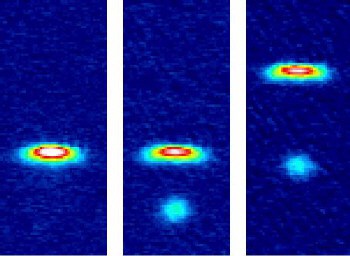The pace of research into the properties of ultracold quantum gases continues to accelerate. Researchers at the University of Innsbruck in Austria produced a Bose-Einstein condensate in cesium for the first time last year. Now Rudi Grimm and colleagues have brought the cesium atoms in the condensate together to form an ultracold gas containing around 3000 cesium molecules (J Herbig et al. 2003 Sciencexpress 1088876). Meanwhile physicists at the Laboratoire Kastler Brossel in Paris have created giant molecules of helium in another experiment with ultracold atoms (J Léonard et al. 2003 Phys. Rev. Lett. 91 073203)
Bose-Einstein condensation occurs when a gas of atoms is cooled until the de Broglie wavelength of the atoms is comparable with the distance between them. When this happens, all the atoms collapse into the same quantum ground state. Researchers made the first condensate of atoms in 1995, and since then condensates have been produced in a total of eight different elements.
The techniques used to cool atoms do not work with molecules so the preferred approach to making an ultracold molecular gas has been to use laser or magnetic fields to make the atoms form molecules. So far this approach has only worked with rubidium-85. Earlier this year physicists also formed ultracold molecules of potassium-40, which is actually a fermionic atom and therefore forms a degenerate Fermi gas rather than a Bose condensate.
Grimm and co-workers started with about 60,000 ultracold cesium atoms in an optical trap, and then applied a magnetic field to produce a weakly bound state known as a ‘Feshbach resonance’. By carefully tuning the value of the magnetic field, the resonance energy can be made equal to the energy of the atoms and this leads to the formation of molecules.
The Innsbruck team then applied a magnetic levitation field to the sample and switched off the optical trap. Since the molecules have a smaller magnetic moment than the atoms, they start falling and this allows them to be detected. The detection scheme involved splitting the molecules back into atoms with a reverse magnetic field and immediately imaging the atoms with a short laser pulse. This reveals the profile of the molecular cloud (see figure).
Grimm and co-workers observed a slow expansion of the molecules, which they say is indicative of a macroscopic matter wave – or molecular Bose-Einstein condensate. “We can’t prove this at the moment, but we are working on interferometric experiments to verify the coherent nature of this wave packet,” said Grimm. “The race is on to make a Bose condensate of molecules and we expect that many other groups will adopt the tricks we used. This may be the advent of a new field of research in molecular quantum gases.”
The Paris team created giant helium molecules by using a laser to bring ultracold atoms in a magnetic trap together. The molecules had a minimum size of 8 nanometers and a maximum size of about 60 nanometres – making them the largest diatomic molecules ever formed by a factor of five.
The Paris team exploited a novel calorimetric detection scheme based on heating of the gas caused by the decay of the molecules. Spectroscopic measurements of the molecules also agreed with theoretical predictions. The neutral helium atoms would not normally form molecules but the laser causes a short-lived separation of positive and negative charge in the atoms, and these dipoles cause the atoms to attract each other.




